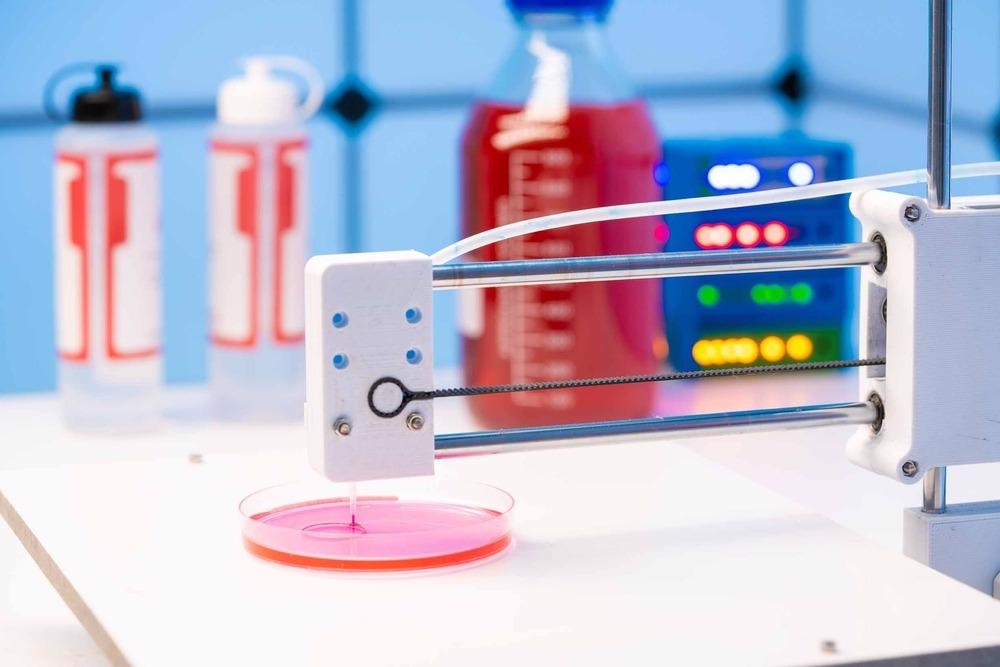A new paper published in Bioprinting has reviewed the field of 3D plant cell bioprinting. Current and future perspectives have been thoroughly investigated in the review study, as well as limitations with current technologies and potential future applications. Scientists from SEGULA technologies and Université Lyon 1 in France have contributed to the paper.

Study: Green 3D bioprinting of plant cells: A new scope for 3D bioprinting. Image Credit: luchschenF/Shutterstock.com
Bioprinting
Additive manufacturing, otherwise known as 3D printing, has been widely applied in several industries to produce numerous commercial products from materials such as ceramics, metals, polymers, and biomaterials. These manufacturing processes offer significant benefits over traditional methods, including freeform design, multi-material printing, and reduced waste materials and post-processing steps.
Additive manufacturing has shown promise in the field of biofabrication. Alongside the development of additive manufacturing processes, progress in tissue engineering has allowed the production of biomaterials with complex architectures and functional properties using additive manufacturing processes. This provides significant benefits for regenerative medicine.
Tissue constructs are produced using bioink, which can be produced from a multitude of biomaterials and living cells. Bioink selection is crucial to fabricating constructs with the desired shape and properties, as well as allowing the growth and proliferation of viable cells within the three dimensional engineered tissue architecture after printing. Polymer hydrogels are commonly used for this purpose.
Different 3D bioprinting methods have been developed in recent years, including inkjet bioprinting and microextrusion bioprinting. Microextrusion bioprinting offers the possibility of highly populated, centimeter-scale scaffolds which are similar in size and shape to organic structures. Moreover, viscous hydrogels can be printed using microextrusion techniques.
Other methods developed in recent years include light-based methods and single-cell fabrication processes using laser-assisted bioprinting. There has been limited success with some of these methods. The field of 3D-plant cell bioprinting, which has benefits for the food and agriculture industries as well as sectors such as bioelectricity generation, has received increased research focus.
The Study
The new review has investigated the current state-of-the-art in 3D green plant cell bioprinting. Several precursory studies have been highlighted and investigated by the authors to provide current perspectives on the printing of tissues from green plant cells. Sixty-six studies have been analyzed in the review.
The authors have noted the lack of research, taking the knowledge gained from advances in tissue engineering and applying this to plant tissue cultures to produce functional tissues. Currently, green plant cell bioprinting is in its infancy.
Some Recent Studies on Green Bioprinting
Since the introduction of green bioprinting in 2015, several studies have been performed in this field. Edible plant cells have been printed for the food industry, with the aim of achieving similar textures to natural food. For instance, lettuce leaf cells have been used to screen for pectin-based bioink compositions.
Another recent study of Zinnia elegans, has demonstrated cell differentiation by modifying plant hormones within the 3D printed construct. This study has provided pertinent information for the study and control of 3D-printed plant cell structural properties.
Light-assisted methods have been developed to indirectly print rice cells within photo-crosslinked hydrogels. Studies have printed rice cells with enhanced metabolic activity, which can be used for the secretion of biodefence agents against nerve agents, neurogenerative diseases, and cocaine toxicity.
The authors have noted that current research has mostly focused on land plant cells, with little investigation of micro-algae. Single and clustered cells have been used in studies, with one study reporting bioprinting with agglomerates of one hundred cells, which requires large bioprinting nozzles. Whilst this field is in its infancy, the number of studies on plant cell bioprinting is growing.
Bioinks and Post-Processing Methods
Bioink formulation impacts the printing of plant cells in the same way as animal cells. Common bioinks used for plant cell bioprinting include methylcellulose, gellan cum, nanocellulose, carrageenan, agarose, bacterial cellulose, alginate, silk, and pectin. Most of the current studies have reported the use of agarose, but on its own, this biomaterial suffers from shear-thinning behaviors, facilitating the use of other biomaterials.
Several post-processing strategies have also been developed in recent years to improve scalability and shape stability in printed products. Additives and cross-linking agents have been evaluated for their improvement of dimensional stability and physical and mechanical properties. Research is ongoing into the improvement of post-processing steps to produce viable 3D-printed plant cell tissues.
In Summary
The review has comprehensively explored the field of 3D printed plant cells, highlighting several studies in the current literature. Current advances in the field are promising, but challenges still exist that need to be addressed by researchers.
Amongst future perspectives highlighted in the paper is the possibility of controlling cell fate by modulating the cell’s micro-environment. This provides possibilities for realizing plant organogenesis and producing specialized plant tissues such as wood, as well as providing new routes to producing renewable resources. There are also significant opportunities for lab-produced foodstuffs.
More from AZoM: Use and Applications of Flame Atomic Absorption Spectroscopy
Further Reading
Landerneau, S et al. (2022) Green 3D bioprinting of plant cells: A new scope for 3D bioprinting Bioprinting e00216 [online, pre-proof] sciencedirect.com. Available at: https://www.sciencedirect.com/science/article/pii/S2405886622000264?via%3Dihub
Disclaimer: The views expressed here are those of the author expressed in their private capacity and do not necessarily represent the views of AZoM.com Limited T/A AZoNetwork the owner and operator of this website. This disclaimer forms part of the Terms and conditions of use of this website.